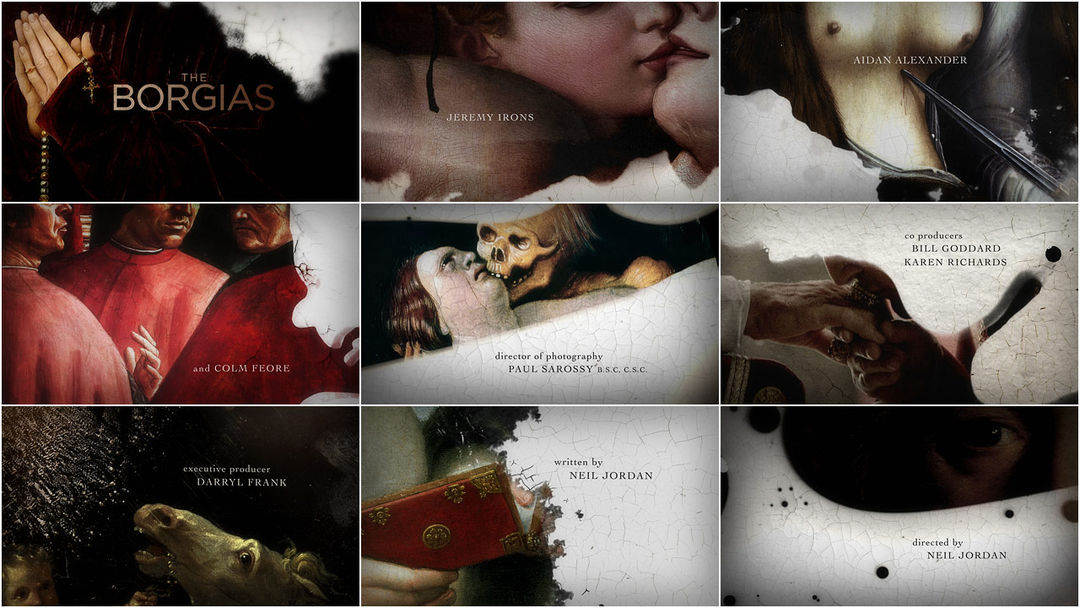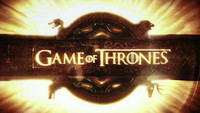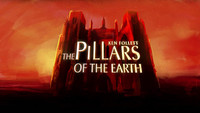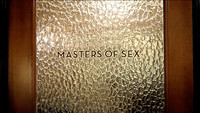In The Borgias lush opening sequence, pious palms grip rosaries as beads of ichor seep through canvas bedaubed, inking avarice and lusty limbs groaning. Bon Boullogne's Triumph of Neptune, Caravaggio's Death of the Virgin, Agnolo Bronzino's Exposure of Luxury: these moldering Renaissance and Baroque masterpieces murmur heavy the echo of desire. And when stillness overcomes the wild flow of exquisite stains, there gapes a single eye, staring back.
A discussion with Designer GARRY WALLER at Momentist, Inc.
How did you get involved with the project?
GW: I've worked with Showtime for a number of years on various show packages and have a great working relationship with them. In this case, after helping with initial promo material for The Borgias series they asked if I wanted to be involved with the opening titles. It was a no-brainer!
How did you go about developing the concept with Showtime?
A number of concepts were initially explored and presented, but this direction seemed to tick all the right boxes. With Showtime in particular I'm often briefed on a job and given space to develop a number of designs that could potentially work. I always enjoy working with Christina Black (Creative Director)—she has a great design sense and a lot of experience. She's one of those CDs who knows exactly how to balance stepping back and letting creatives do their thing and when to offer guidance and direction. Two other people who helped in the development and production process are Alexis Ames (Art Director), who collaborated on the creative side of things and offered great insight as it all moved along, and Mark Auleta (Animator), who I've worked with on numerous other Showtime assignments and who really helped nail a lot of the key animation to bring the sequence to life.

Initial styleframes
The Italian Renaissance is perhaps best known today for the extraordinary art it produced, less so for its politics and intrigue. Can you talk about the decision to use paintings and paint as the central motif of the title sequence?
Neil Jordan, the show's director, wanted something dramatic and powerful. He responded well to the paintings as a concept because of their richness and symbolic references to themes within the show. The Borgias dynasty is synonymous with corruption during their rise to power and their struggles to hold on to it. Greed, theft, rape, murder, bribery, and incest all played a part in the story, so historic paintings served as a great way to hint at some of these tasty attributes. The use of paint and ink was a great visual device to add movement and texture to the whole piece. It was also a real practical asset to help weave the whole sequence together and help reveal images and footage.
Paintings of the famed suicide of Lucretia reoccur throughout the sequence, presumably in reference to one of the show's main characters, Lucrezia Borgia. How were the other paintings in the sequence chosen and why?
Absolutely. Symbolically the surface texture and cracks helped echo the idea of decay which sat well with the beauty and decadence of the paintings. I already knew from my earlier work onThe Borgias identities what the title sequence needed in terms of mood and symbolism so I kind of hit the ground running with this! The main thing was to draw the viewer in with glimpses of the story and all the debauchery without giving too much away—I think that's the aim of any good title sequence.

Ink tests
How did you decide on the order of the painterly flourishes? How did you emulate the textures of the artwork?
We shot a lot of textures and paints and assembled a fairly sizable library to pick and choose from. The selects we ended up using were the ones that had the most interesting movement and that served us well as compositing and transitional elements. It became a very organic process of trial and error to build a sequence that felt editorially right. Everything was brought into After Effects where we were able to apply camera moves, add further textural elements, color-correct and really finesse the details. It was vital that the piece retain a look that felt "hand-made" and very tactile. It was accepted from the get-go that this shouldn’t feel like it was computer-generated.
Can you speak more specifically about the materials you had to use to create these effects? Did you have piles of different weights of paper and canvas, eyedroppers with oils and inks, that sort of thing?
After a trip to a couple of art stores, we had at our disposal an arsenal of paints, oils, paint repellants and different surfaces including paper, card, wood, plastic and glass. Shooting was a process of just trying things out with all the various materials we had and certain things just worked well—trapping ink and oil between two layers of plexi was a good one!
It seems like symbolically there's a juxtaposition of stone and liquid, the perfection of the paintings marred by cracking canvas—a sense of impermanence and corruption. Was this intended? What sort of direction did you receive in terms of the mood and symbolism?
A fair amount of time was spent trying to find paintings that were both visually beautiful and menacing at the same time. We took some artistic liberty on when and where some of the paintings were created, so not all were Italian Renaissance artworks but because they had exactly the right feel for what we wanted we bent the rules slightly! The themes of the show were always in the back of my mind as I was compiling the selects so it was simply a case of choosing images that felt visually appropriate to the story and that looked great. By carefully cropping the paintings and showing only certain details we were able to create a loose narrative. The whole sequence was originally designed to rely on paintings alone but it was felt by the powers that be that we needed to accommodate footage as well.

Paintings used
Full paintings list:
01 Philippe de Croy, Seigneur of Sempy by Rogier van der Weyden, 1399 - 1464
02 Exposure of Luxury by Agnolo Bronzino, 1545
03 Lucretia by Lucas Cranach the Elder, c. 1472-1553
04 Judith with the head of Holofernes by Lucas Cranach the Elder, 1530
05 Zachariah in the Temple detail by Domenico Ghirlandaio, 1486-1490
06 Farinata degli Uberti alla Battaglia del Serchio by Giuseppe Sabatelli, 1842
07 Death of the Virgin by Caravaggio, 1604-1606
08 Death and a Woman by Hans Baldung Grien, 1517
09 Triumph of Neptune by Bon Boullogne, 1649-1717
10 The Artist's Sister Elena Anguissola as a Nun by Sofonisba Anguissola, 1532-1625
11 Execution Without Trial under the Moorish Kings in Granada by Henri Alexandre Georges Regnault, 1870


































